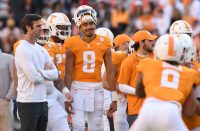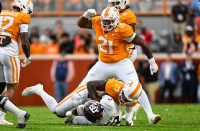That’s a lot of alphabet soup in the title. FPI (Football Power Index) is an ESPN metric; as such you’ll see it a lot on their coverage, in playoff conversations, etc. S&P+ is a metric used by Bill Connelly at SB Nation and Football Outsiders, measuring what it believes to be the four factors most critical to success (efficiency, explosiveness, field position, and finishing drives) plus turnovers.
Both are useful, among many other ways, in their projected win probabilities which update each week. Bill Connelly released his excellent 2017 Tennessee preview today, which gives us a look at S&P+’s projected odds for Tennessee each week. An FPI projection for Tennessee is also available at ESPN.com.
Before diving into their numbers, think of it this way for your own odds: what percentage chance would you give Tennessee to win each game?
Add up all those percentages, and you’ll get your projection for Tennessee’s record this year. It’s one thing to say you think the Vols should go a generic 9-3 or 5-7. This way of thinking it through usually involves statements like, “Missouri, we’ll beat them.” The Vols should be favored, no doubt, but there’s a difference in assuming an automatic win (of which there are virtually none in the SEC anymore) and saying you give Tennessee an 85% chance.
The Vols are favored in nine games by both FPI and S&P+. But neither projects the Vols to go 9-3. This is because the percentages on so many games are close enough to 50%, the most likely outcome is the Vols will lose one or two they’re actually favored to win. This is what happens to almost everyone: how many power conference teams who were favored in at least six games never lost to an underdog? Last year, the answer was four: Georgia Tech, Nebraska, Penn State, and Southern Cal. Saying you think Butch Jones will lose one he shouldn’t is basically saying you think Butch Jones is like most coaches in college football (Jones is 27-6 as a favorite at Tennessee and has covered the spread as a favorite better than anyone other than Missouri in the SEC). Upsets happen.
When you add the percentages, FPI projects the Vols to finish around 8-4; S&P+ projects a finish around 7-5. It’s an interesting neutral perspective. Here’s the comparison with Tennessee’s win probability for each game:
| Opponent | FPI | S&P+ |
| vs Georgia Tech | 68% | 56% |
| Indiana State | 99% | 98% |
| at Florida | 38% | 30% |
| UMass | 97% | 93% |
| Georgia | 51% | 51% |
| South Carolina | 76% | 66% |
| at Alabama | 14% | 7% |
| at Kentucky | 60% | 57% |
| Southern Miss | 96% | 87% |
| at Missouri | 64% | 61% |
| LSU | 47% | 29% |
| Vanderbilt | 81% | 74% |
Note the differences:
- How much of a toss-up is Georgia Tech? S&P+ puts it squarely in that category, giving the Vols a 56% chance to win. FPI is much more bullish on the Vols at 68%; other than the 18-point swing in their LSU projections, this is the biggest difference on the board. Vegas has the Vols as a 3.5 point favorite, so I’d say it qualifies as a toss-up.
- I think S&P+’s odds for Florida are too low. Tennessee has had the better team in this match-up three years in a row, and has recruited as well or better than the Gators in that span. Maybe Florida gets elite quarterback play from Malik Zaire to make this difference; I’m not saying the Vols should be favored, but if they played 10 times I think Tennessee wins more than three.
- Everything about the Georgia game suggests a toss-up. And history is the strongest indicator there: the last six have been decided by one possession, three of the last four on the final play of the game.
- What is Tennessee’s most difficult game after Alabama, LSU, Florida, and Georgia? FPI says it’s at Kentucky (60%). S&P+ gives the nod to Georgia Tech, but by only a singe percentage point over Kentucky (57%). No one likes the timing of that trip to Lexington the week after Tuscaloosa.
If you blindly assume the Vols will win all the games they’re favored in, you’re probably thinking 9-3 or better. If you blindly assume every game other than Alabama and the non-power-conference games are true toss-ups, you’re probably thinking 7-5 or worse. I think the latter assumption is safer, but the truth is usually in the middle. And in this case, the data can support what I believe will be the majority projection of 8-4.




Will,
How does the S&P+ make any projections based on efficiency, explosiveness, field position, and finishing drives for us this year? We basically have an entirely new offense (except for the OL) this year. They haven’t played a snap yet. An offensive under Dormady or Guarantano might be significantly more explosive… or not. We really have no idea. I would understand the numbers if we were returning almost all the starters from last year. This just seems like pure guesswork on their part though.
Andrew
I don’t know the nuts and bolts of how Bill makes preseason projections in S&P+; I know his in-season projections include a portion of last year’s data in the first few weeks of the season. I would assume it includes tendencies, yardage lost, recruiting evaluations, etc. Not exactly sure how the sausage is made in August, but I know it tastes pretty good later in the year.
S&P+ is based on largely on the percentage of returning production from the previous year, along with a several year trend line. Tennessee’s offense, for example, takes a hit from losing Dobbs, Kamara, Hurd, and Malone, but fairs well from previous years under Jones.
That’s why S&P+ loves Florida so much– it thinks the defense will remain in the same ballpark as previous years. You might look at the Gators and say, “Hey, they lost a bunch of talent and their coordinator.” S&P+ sees returning production from backups last year and says, “No problem.”
Good to know.